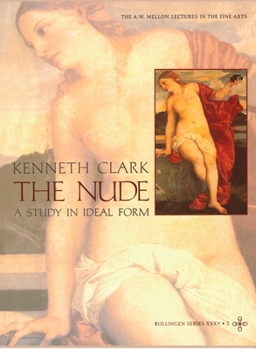The Nude: A Study in Ideal Form
Select Format
Select Condition 
Book Overview
A landmark study of the nude in art--from the ancient Greeks to Henry Moore--by a towering figure in art history
Format:Paperback
Language:English
ISBN:0691017883
ISBN13:9780691017884
Release Date:October 1972
Publisher:Princeton University Press
Length:480 Pages
Weight:2.11 lbs.
Dimensions:1.3" x 7.4" x 9.9"
Customer Reviews
4 ratings
Essential reading material
Published by Thriftbooks.com User , 16 years ago
It seems like nearly everyone who has an opinion about nude art has read this seminal work. Sir Clark's arguments are well-formed, thought-provoking, and amply legitimized by references to other sources. If you are interested in the debate surrounding nude art, then you should absolutely read this book, and John Berger's "Ways of Seeing," which includes a chapter where he specifically debates Sir Clark's book. If only our modern politicians could express themselves with such grace and consideration for each other!
A Classic Investigation and Summation
Published by Thriftbooks.com User , 20 years ago
THE NUDE: A STUDY IN IDEAL FORM is one of scholar/historian Kenneth Clark's finest works - and that is high powered praise in view of all of his contributions to literature. Few writers inform with such dignity of prose, style, and warmth as Clark and THE NUDE is no exception. This handsome and illuminating volume dates back to 1953 and is based on six lectures given by Clark for the A. W. Mellon Lectures in Fine Arts at the National Gallery in Washington, DC. Clark opens his book with a lyrical treatise "The Naked and the Nude" in which he not only introduces his manner of examining the use of the nude as pictorial image for artists from ancient Greece through the Renaissance to the present, he wraps his scholarly information with personalized psychosocial commentary that is uniquely his own and allows the reader to settle in for the exploration ahead. Approaching first the male nude ["Apollo"] from the Kouros of 600 BC through the vases, sculptures, reliefs, and paintings from all periods of history, he then moves to two views of the female nude - Venus I [the celestial female form] and Venus II [the woman of earthly form]. Having laid the foundation for the use of the nude in general, he then addresses the artistic emotions of Pathos, Energy, and Ecstasy in a manner that is near novel-like in reading. He closes his lecture series/book with a thought-provoking discussion of how man has viewed the nude through history, vacillating between laud and honor to the depiction of guilt, of the human stain. And finally he demonstrates in "The Nude As An End In Itself" both the occult appropriation of repeated forms and the acknowledged plagiarism of the nude studies from the earliest to the current. The Book is generously illustrated but in the paperback version available the illustrations are in black and white only. This profound and warmly human book is a must for artists and art lovers alike. Highly Recommended
Throws light into the corners of a subject often misplaced.
Published by Thriftbooks.com User , 26 years ago
Would you want to read someones recollections on art gone by, I doubt it. Perhaps you want to hear the love-less dissection of art by an academic, probably not. Maybe you'd like to see someone capture the beating heart in a subject that by it's very nature evokes stares, of course you do Malcolm. Lord Clark draws you into his diction, not because he wants you to bear witness to the eloquence of his analysis, but because he has remembered that there is more to seeing than meets the eye.
A well thought out discussion of the Western tradition
Published by Thriftbooks.com User , 27 years ago
Whether you are a student of the arts, religion, history, or life you will learn from this work. Mr. Clark speaks with the authority of an educated and thoughtful expert on the subject and with the voice of a formidable author as well. His work is as densely packed with meaning as you might expect to find in the writings of Reinhold Niehbur yet is possessed of a wonderfully literary mask. The writing is so well done, one might accidently read right over the meaning in the haste of seeing what will come next. If you're the highlighting or underlining type, I'd recommend saving such marking for the second read as more of the true significance bubbles to the fore. Put aside your expectations of a "typical" art history text and prepare for an incredible enlightenment. Enjoy!





